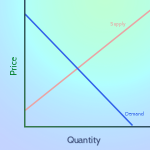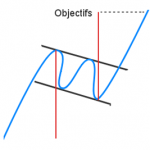
Now that you have a high level understanding of what options are, let’s look at option trading in a little more detail. When you get a quote on a stock you can also call up its option chain:

First of all, you must realize that not all stocks have options. Only the most popular stocks have options.
Second, you cannot always buy the strike price The price at which the option contract can be executed. that you want for an option. Strike prices are generally in intervals of $5. So if YHOO is trading in the $30 range, it might have strike prices of $20, $25, $30, $35, and $40. Occasionally, you will find $22.5 and $27.5 available for the more popular stocks.
Third, you will not always find the expiration month you are looking for in an option. Usually you see the expiration months for the closest two months, and then every 3 months thereafter.
Fourth, even if you do find the option you are looking for, you need to make sure it has enough volume trading on it to provide liquidity so that you can sell it in the open market, if you decide to. Most options are thinly traded and therefore have a high bid/ask spreads.
Finally, you need to understand where option prices are coming from. If YHOO is trading at $27 a share and you are looking at the October $30 call option, the price is determined just like a stock—totally on a supply and demand basis in an open market. If the price of that option is $0.25, then not many people are expecting YHOO to rise above $30; and if the price of that option is $2.00, then you know that a lot of people are expecting that option to rise above $30.
As you might expect, option prices are a function of the price of the underlying stock, the strike price, the number of days left to expiration, and the overall volatility of the stock. While the first 3 of these (stock price, strike price, and days to expiration) are easily agreed upon, it is the volatility and the expected volatility of the stock that traders differ in opinion and therefore drives prices.
When buying options, you need to be able to calculate your break-even point to see if you really want to make a trade. If YHOO is at $27 a share and the October $30 call is at $0.25, then YHOO has to go to at least $30.25 for you to breakeven. This is because when YHOO is at $30.25, then you know that the $30 call is “in-the-money” $0.25 so it is worth at least $0.25 (your cost of the option). Likewise, if the October $30 call is $2.00, then YHOO has to climb to at least $32.00 for you to breakeven (when YHOO is at $32, then the $30 call is “in-the-money” $2.00 and it will be worth at least $2.00.)
Now let’s look at a specific example so this starts making sense. Let’s say we have done our analysis on IBM (IBM) and we think IBM will go from $84 to $87 in the next few days. Because we think IBM will go up, we want to buy a call and since option strike prices are in multiples of $5, I could buy the $80 call, the $85 call, or the $90 call. Note from Table 1 below that the IBM April $85 Call has the greatest percentage return.
Scenario 1
Buy 100 Shares of Stock and 1 Contract of Each of the $80, $85, and $90 Calls and IBM Closes at $87.

Notice in Table 1 that we spent $8,400 on the stock position and we spent very little on the options. Now in the Table 2 below, we go ahead and invest the same initial amount in options as in the stock so we spend $8,400 on 100 shares, of IBM and about the same on each of the calls. Naturally, the percentage return is the same as in Table 1 above but since now look at the $14,000 profit on the April $85 Call! Even the profit on the April $80 call is nice at $6,300.
Scenario 2
Invest Equal Amounts of Money in Each Stock and Option and IBM Closes at $87

Now, here’s the risky part of trading options. In Table 1 and Table 2 we showed the results assuming IBM climbed from $84 to $87 a share by the expiration date The date that the option expires, usually the 3rd Friday of the month in the U.S.. Of course, stocks don’t always move the way we think, so Table 3 shows what happens if the stock price just declines a bit to $83 a share. Note that for the $85 Call we lost all of our money, but for the $80 Call we only lost $2,100 and, of course, for the stock we only lost the $100.
Scenario 3
IBM Closes at $83.00

Conclusion
If you are sure that a stock is going to pop up a few dollars before the next option expiration date, it is the most profitable (and the most risky) to buy a call option with a strike price slightly higher than the current stock price. If you want to be a little more conservative, you can also buy the call option with a strike price below the current stock price. When in doubt as to what option to buy, always look at the volume in the real market and go where the volume is (I call this following the “smart money”).
Here is the one of the most important characteristics about option trading that you must know: Stock prices move in 3 directions–not only do stock prices move up and down, but they also can stay the same. If prices are random, then over a short period of time you would expect stocks to move up 33% of the time, move down 33% of the time, and stay roughly the same 33% of time. This is actually proven out by a lot of academic research that shows that buyers of calls or puts are only profitable about 35% of the time. So, if buyers of calls/puts are profitable only 35% of the time, that means that the sellers of calls and puts are profitable 65% of the time. The next topic addresses selling (also known as “writing” calls).

 Teacher Introduction Webinars
Teacher Introduction Webinars Fundamental Analysis Project
Fundamental Analysis Project Demand
Demand Descending Flag
Descending Flag